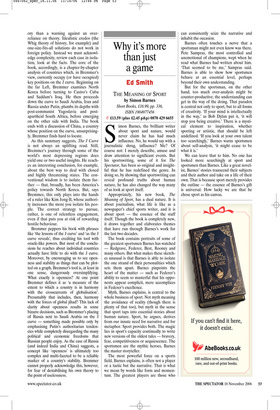Coping with closed regimes
William Skidelsky
THE J CURVE by Ian Bremmer Simon & Schuster, £17.99, pp. 306, ISBN 18004566798 ✆ £14.39 (plus £2.45 p&p) 0870 429 6655 Ian Bremmer, a political risk consultant, has come up with one of those snappy, graph-based theories (think the ‘tipping point’ and the ‘long tail’) which claim to ‘transform’ our understanding of the world, but actually reveal little. Bremmer’s theory is concerned with how nations develop. How can closed, authoritarian regimes be made to embrace democratisation, engagement with other countries and prosperity? To answer this, Bremmer has invented a graph — the J curve — which illustrates the course of a country’s journey. The graph’s two variables are stability (the vertical axis) and openness (horizontal). According to Bremmer, the line that any country must follow describes the shape of a ‘J’ (or, to be strictly accurate, a ‘J’ that has been rotated about 45 degrees in a clockwise direction). A country that is very closed, in other words, can be fairly stable (the left tip of the ‘J’), but not nearly so stable as a country that is very open (the top right-hand side of the ‘J’). The difficulty is getting from one to the other — going from being closed to being open. That, says Bremmer, necessarily entails a period of dangerous instability (the bottom of the ‘J’).
This argument, it must be conceded, has the merit of being broadly true. Going from autocracy to democracy is indeed a destabilising process, as America’s misadventures in Iraq have shown. The trouble with Bremmer’s theory is that, while true, it is also banal. Who ever said that becoming more open doesn’t lead, in the first instance, to instability? Even the most hawkish of Bush’s advisers did not claim that Iraq’s transition to democracy would be seamless. For policy-makers, the distinctions that really matter (or, as Bremmer would put it, the ‘distinctions with a difference’) are not ones of trajectory (will things get worse?) but ones of degree (by how much, exactly, will they get worse, and in what way?). The J curve cannot answer such questions, because it is only concerned with trajectory.
To be fair to Bremmer, his book at least implicitly recognises this. The J curve’s initial plummet makes it, in reality, less a the ory than a warning against an overreliance on theory. Idealistic credos (the Whig theory of history, for example) and one-size-fits-all solutions do not work in foreign policy. Instead we must acknowledge complexity, review each case in isolation, look at the facts. The core of the book, accordingly, is a chapter-by-chapter analysis of countries which, in Bremmer’s view, currently occupy (or have occupied) key positions on the J curve. Beginning on the far Left, Bremmer examines North Korea before turning to Castro’s Cuba and Saddam’s Iraq. He then proceeds down the curve to Saudi Arabia, Iran and Russia under Putin, plumbs its depths with post-communist Yugoslavia and postapartheid South Africa, before emerging on the other side with India. The book ends with a discussion of China, a country whose position on the curve, unsurprisingly, Bremmer finds hard to locate.
As this summary suggests, The J Curve is not always an uplifting read. Still, Bremmer’s journey through some of the world’s most depressing regions does yield one or two useful insights. He reaches an interesting conclusion, for example, about the best way to deal with closed and highly threatening states. The conventional wisdom is to isolate them further — that, broadly, has been America’s policy towards North Korea. But, says Bremmer, this only plays into the hands of a ruler like Kim Jong-Il, whose authority increases the more you isolate his people. The correct strategy to pursue, rather, is one of relentless engagement, even if that puts you at risk of rewarding hostile behaviour.
Bremmer peppers his book with phrases like ‘the lessons of the J curve’ and ‘as the J curve reveals’, thus crediting his tool with oracle-like powers. But most of the conclusions he reaches about individual countries actually have little to do with the J curve. Moreover, by encouraging us to see openness and stability as things that can be plotted on a graph, Bremmer’s tool is, at least in one sense, dangerously oversimplifying. What exactly is openness? At one point Bremmer defines it as ‘a measure of the extent to which a country is in harmony with the crosscurrents of globalisation’. Presumably that includes, then, harmony with the forces of global jihad? This lack of clarity about openness results in some bizarre decisions, such as Bremmer’s placing of Russia next to Saudi Arabia on the J curve — something made possible only by emphasising Putin’s authoritarian tendencies while completely disregarding the many political and economic freedoms that Russian people enjoy. As the case of Russia (and indeed India and China) suggests, a concept like ‘openness’ is ultimately too complex and multi-faceted to be a reliable marker of a country’s stability. Bremmer cannot properly acknowledge this, however, for fear of destabilising his own theory to the point of uselessness.



































































































 Previous page
Previous page